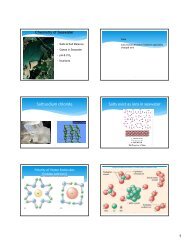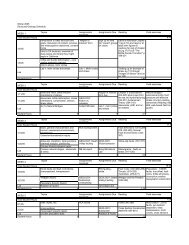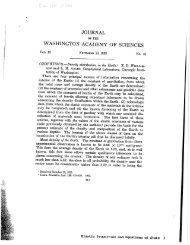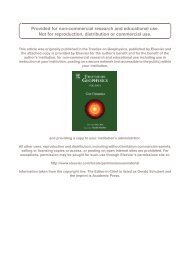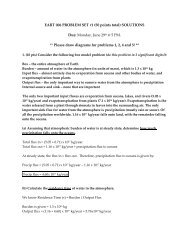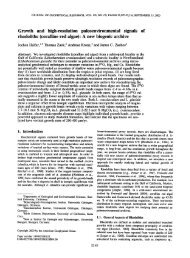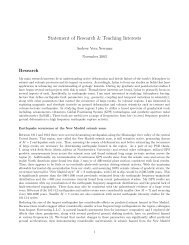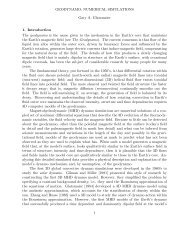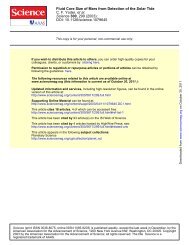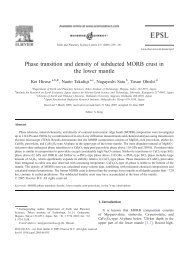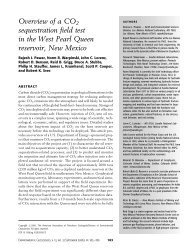From Greenhouse to Icehouse – The Eocene/Oligocene - UMass ...
From Greenhouse to Icehouse – The Eocene/Oligocene - UMass ...
From Greenhouse to Icehouse – The Eocene/Oligocene - UMass ...
You also want an ePaper? Increase the reach of your titles
YUMPU automatically turns print PDFs into web optimized ePapers that Google loves.
Developments in Earth & Environmental Sciences, 8<br />
F. Florindo and M. Siegert (Edi<strong>to</strong>rs)<br />
r 2009 Elsevier B.V. All rights reserved<br />
DOI 10.1016/S1571-9197(08)00008-6<br />
Chapter 8<br />
Author's personal copy<br />
<strong>From</strong> <strong>Greenhouse</strong> <strong>to</strong> <strong>Icehouse</strong> <strong>–</strong> <strong>The</strong><br />
<strong>Eocene</strong>/<strong>Oligocene</strong> in Antarctica<br />
J. E. Francis 1 , S. Marenssi 2 , R. Levy 3 , M. Hambrey 4, , V. C. Thorn 1 ,<br />
B. Mohr 5 , H. Brinkhuis 6 , J. Warnaar 6 , J. Zachos 7 , S. Bohaty 7 and<br />
R. DeCon<strong>to</strong> 8<br />
1 School of Earth & Environment, University of Leeds, Leeds, LS2 9JT, UK<br />
2 Institu<strong>to</strong> Anta´rtico Argentino, Universidad Buenos Aires and CONICET, Buenos<br />
Aires 1010, Argentina<br />
3 Geosciences, University of Nebraska Lincoln, Lincoln, NE 68588, USA<br />
4 Institute of Geography and Earth Sciences, Aberystwyth University, Ceredigion SY23<br />
3DB, Wales, UK<br />
5 Humboldt-Universita¨t zu Berlin, Museum fu¨r Naturkunde, D-10099 Berlin, Germany<br />
6 Palaeoecology, Department of Biology, Faculty of Sciences, Labora<strong>to</strong>ry of<br />
Palaeobotany and Palynology, Utrecht University, Budapestlaan 4, 3584CD Utrecht,<br />
<strong>The</strong> Netherlands<br />
7 Earth and Planetary Sciences Department, University of California, Santa Cruz, CA<br />
95064, USA<br />
8 Department of Geosciences, University of Massachusetts, Amherst, MA 01003, USA<br />
ABSTRACT<br />
<strong>The</strong> change from a warm, ice-free greenhouse world <strong>to</strong> the glacial Antarctic<br />
icehouse occurred during the latest <strong>Eocene</strong><strong>–</strong>earliest <strong>Oligocene</strong>. Prior <strong>to</strong> this,<br />
during the Early<strong>–</strong>Middle <strong>Eocene</strong>, Antarctica experienced warm climates, at least<br />
on the margins of the continent where geological evidence is present. Climates<br />
appear <strong>to</strong> have been warm and wet, the seas were warm and plants flourished in a<br />
frost-free environment, although there is some suggestion of valley glaciers on<br />
King George Island. Climate signals in the geological record show that the climate<br />
then cooled but not enough <strong>to</strong> allow the existence of significant ice until the latest<br />
<strong>Eocene</strong>.<br />
Glacial deposits on Seymour Island indicate that ice was present there at<br />
<strong>Eocene</strong>/<strong>Oligocene</strong> boundary times. Further south, ice-rafted clasts in drill cores<br />
Corresponding author. Tel.: +44(0)1970 621860;<br />
E-mail: mjh@aber.ac.uk (M. Hambrey).



